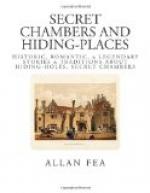[Footnote 2: State Papers, Domestic (James I.).]
There is an old timber-framed cottage near the modern mansion of Hindlip which is said to have had its share in sheltering the plotters. A room is pointed out where Digby and Catesby concealed themselves, and from one of the chimneys at some time or another a priest was captured and led to execution.
CHAPTER III
PRIEST-HUNTING AT BRADDOCKS
In the parish of Wimbish, about six miles from Saffron Walden, stand the remains of a fine old Tudor house named Broad Oaks, or Braddocks, which in Elizabeth’s reign was a noted house for priest-hunting. Wandering through its ancient rooms, the imagination readily carries us back to the drama enacted here three centuries ago with a vividness as if the events recorded had happened yesterday. “The chapel” and priests’ holes may still be seen, and a fine old stone fireplace that was stripped of its overmantel, etc., of carved oak by the “pursuivants” in their vain efforts when Father Gerard was concealed in the house.
[Illustration: BRADDOCKS, ESSEX]
[Illustration: FIREPLACE AT BRADDOCKS]
The old Essex family of Wiseman of Braddocks were staunch Romanists, and their home, being a noted resort for priests, received from time to time sudden visits. The dreaded Topcliffe had upon one occasion nearly brought the head of the family, an aged widow lady, to the horrors of the press-yard, but her punishment eventually took the form of imprisonment. Searches at Braddocks had brought forth hiding-places, priests, compromising papers, and armour and weapons. Let us see with what success the house was explored in the Easter of the year 1594.
Gerard gives his exciting experiences as follows[1]:—
[Footnote 1: See Autobiography of Father John Gerard.]
“The searchers broke down the door, and forcing their way in, spread through the house with great noise and racket.
“Their first step was to lock up the mistress of the house[2] in her own room with her two daughters, and the Catholic servants they kept locked up in divers places in the same part of the house.
[Footnote 2: Jane Wiseman, wife of William Wiseman. N.B.—The late Cardinal Wiseman was descended from a junior branch of this family. See Life of Father John Gerard, by John Morris.]
“They then took to themselves the whole house, which was of a good size, and made a thorough search in every part, not forgetting even to look under the tiles of the roof. The darkest corners they examined with the help of candles. Finding nothing whatever they began to break down certain places that they suspected. They measured the walls with long rods, so that if they did not tally they might pierce the part not accounted for. Then they sounded the walls and all the floors to find out and break into any hollow places there might be.




